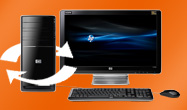PC Learning Center
Support & Drivers

Introduction
As the workhorse of your PC, your hard drive naturally needs periodic fine-tuning. This upkeep does not require an enormous amount of time, and can even be done automatically on new HP PCs using an application called HP Support Assistant. If you do not have HP Support Assistant, do not want to automate some clean-up tasks, or want to do a more thorough clean-up, every three months or so, follow the four simple steps outlined below to organize and streamline your hard drive so it can maintain optimal health.
1. Remove clutter and old programs.

Start this “purge process” by taking a look at the short-cut icons on your desktop. Because it takes time for your PC to find these icons when it boots up, delete them or turn them off with a swift right click if you don’t need easy access to them.
Next, if you don’t need all those individual files, pictures and MP3s on your desktop, start categorizing them into folders. This is also a good time to go through the contents of folders you have already created and delete any duplicate files or those you no longer use. Microsoft® Windows® XP comes with already-labeled folders such as “My Documents,” “My Photos” and “My Music” to help organize your files accordingly—and eliminate the clutter on your PC’s desktop.
Lastly, if you’ve never used a particular software program that came with your PC or haven’t used it in over a year, consider getting rid of it. To delete a software program:
1. Click Start, and point to Settings.
2. Point to Control Panel, and double-click Add/Remove Programs.
3. Click the software program you want to delete.
4. Click the Change/Remove button, and follow the instructions on the screen to start the removal process.
Alternatively, you can use the “Uninstall” feature that comes with the software program you’d like to delete. However you choose to remove the program, empty your PC’s Recycle Bin after the removal has taken place.
2. Clear out the cache.
Every time you visit a new website, content is automatically stored in your “Temporary Internet files” folder, otherwise known as a cache. These files slow down hard drive speed by taking up valuable storage space. The “Tools” function provided by Microsoft® Internet Explorer allows you to delete these files. To clear out the cache in Internet Explorer:
1. Click Tools and then Internet Options.
2. Under Temporary Internet files, click Delete Files.
3. Clean up even more.
Disk Cleanup, a handy tool that comes with Windows® XP, allows you to easily sort through and delete unused and temporary files, freeing space on your hard drive and speeding up its operation. To access Disk Cleanup:
1. Click Start, and point to Programs.
2. Point to Accessories and then to System Tools.
3. Click Disk Cleanup.
4. Choose the drive you want to scan from the drop-down menu, and click OK.
5. Wait while Disk Cleanup calculates how much space is available for cleanup. This step may take a few minutes.
6. Click the “Disk Cleanup” tab and then the checkbox(es) next to the type(s) of files you want to delete.
7. Click OK to start the cleanup process. Depending on the amount of files you want to delete, this may take several minutes.
4. Defrag your hard drive.
As you work on your PC, it stores your data in bits and pieces on its hard drive, wherever there is space. Imagine various chapters of a book being deposited in different places throughout your home. When you open a certain file, your PC runs around gathering all these “chapters” (creating the whirring sound you may have heard).
Enter Disk Defragmenter, another powerful utility included in Windows® XP. Reorganizing that scattered data on your hard drive, Disk Defragmenter also moves the files you use most to the beginning of your hard drive, so they load faster and your PC runs more efficiently. To access Disk Defragmenter:
1. Click Start, and point to Programs.
2. Point to Accessories and then to System Tools.
3. Click Disk Defragmenter.
4. Once Disk Defragmenter tool appears, click the “Analyze” button, which will show you how much time you’ll need for defragging. Depending on the amount of files on your hard drive, this step may take a few hours.
5. After the defrag tool analyzes your hard drive, follow the instructions on the screen to start the defrag process.
Disk Defragmenter’s bottom frame displays its progress, and you can interrupt or temporarily discontinue it by clicking on “Stop” or “Pause.” While you can use your PC while defragging, the process slows down other applications, so you’re best off utilizing Disk Defragmenter when you don’t need to work on your PC, like when you go to bed.
Note that your PC’s hard drive must have at least 15% free space for Disk Defragmenter to completely and adequately defrag it. If your hard drive has less than 15% free space, Disk Defragmenter will only partially defrag it. To increase your hard drive’s free space, delete even more files that you don’t use or move your files to another drive or device such as the HP Personal Media Drive.
If you organize and clean up your PC’s hard drive as described, it will be the well-oiled machine it should be—and remain healthy and run smoothly for years to come!